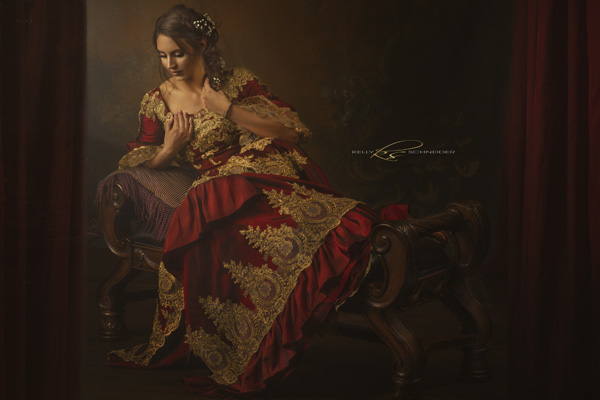
by successfulbob | fine art portrait, inspiration, people photography, photographer profile, photography, photography creativity, tuesday painterly photo art
Tuesday Painterly Artist – Kelly Schneider
PPA – Photographic Craftsman & Certified Professional Photographer
The work in these Painterly Posts are usually a bit more on the obvious painting side using the digital tools we have. Today’s artist is one I’ve been following for a while and while it is not specifically a painting style the work in my opinion transcends photography into a realm of it’s own. I’ll leave you to decide… Let me know what you think of Kelly’s work.
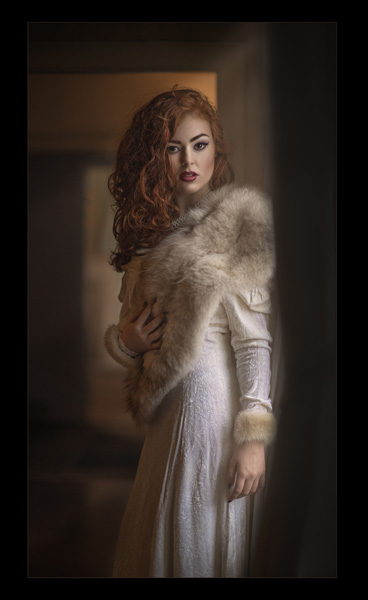
Elegant Shades of Red © Kelly Schneider
Kelly’s Start
Kelly got his start while traveling in the US Navy starting a business called Captured Journeys Photography. He shares, “Initially, I knew so little about photography and anyone doing it that I was not influenced except that I wanted to get great images! After a few years, I realized that if I was ever going to really grow my game and produce good work, I needed to invest in my craft and my skills. That is when I started looking at true professionals who were masters. I realized I knew next to nothing!” Schneider notes an early influence for stepping up his game was Trey Ratcliff of Stuck in Customs fame.
A True Professional
When asked what makes a true professional photographer Kelly said, “I think being a true professional has little to do with how many hours or if it is a full-time thing. A true professional is someone who has dedicated and committed themselves with all facets of a skill or craft and invested in both time and resources to grow and develop their knowledge, skill, and ability to be recognized for their work. Being a true professional and doing it full time is another layer. It is just a measurement of how much time you are doing it, not how much of a master you are while doing it.”

KS Fine Arts Portrait
Changes in Photography
Changes in professional photography are coming fast and furious and while Kelly recognizes the single most impact in photography comes from those photographers who can leverage the changes. “The single most impacting element in learning photography (outside of the core ability to “SEE” light and render wonderful and powerful images, is the capacity to learn and use more complex and advanced technology in your photography.” According to Kelly. “Those who have a natural and gift for awesome photography will find themselves fading into the “non relevant” layers of photographers if they don’t embrace and learn how to bring new and exciting technology into their game. From the expanded things a photographer can do with such little effort with lighting and tech, is making it harder and harder to separate yourself from the over 44 million practicing photographers in the USA.

Elegant Stylized Portrait © Kelly Schneider
To be Continued
I’ll continue this post with Kelly next week when we find out why Kelly teaches other photographers his techniques and where he sees photography going in the next ten years…
Portfolio: https://www.500px.com/kellyschneider
Instagram: http://instagram.com@ksfinearts
Kelly’s Bio
 Born and raised in Coronado California he joined the US Navy in 1980 and served for 29 years. During his US Navy travels including 137 countries, he began “capturing” life around him. In 2010, Kelly began his pursuit of professional portraiture, growing and developing his skills in creating “salient” portraits focused on weddings portraiture and boudoir.
Born and raised in Coronado California he joined the US Navy in 1980 and served for 29 years. During his US Navy travels including 137 countries, he began “capturing” life around him. In 2010, Kelly began his pursuit of professional portraiture, growing and developing his skills in creating “salient” portraits focused on weddings portraiture and boudoir.
Over time, Schneider has become passionate about teaching others. He earned a Master’s degree in Human Systems Integration from the Navy Post Graduate School in Monterey California. He completed the Executive leadership course at both UC Berkeley and Duke University and is a MDPPA Board of Directors member for 2019.
Kelly and his wife Kalina (also a gifted photographer and active PPA member/Maryland PPA member) have been hosting workshops both in the US and in Europe. Kelly Schneider Fine 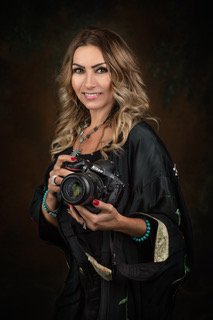 Arts ksfinearts.com focuses on Boudoir and Fine Art portraiture and workshops.
Arts ksfinearts.com focuses on Boudoir and Fine Art portraiture and workshops.
Schneider is writing his first book “The Salient Portrait – the science behind it and how to achieve it” and it is a core element of all his workshops and training events. He earned the Best Portrait of the Year award in 2017 for MDPPA and Best Portrait Photographer for the State of Maryland for 2017 and 2018 and Wedding Photographer of the year for 2018 as well as earning two Fujifilm Masterpiece Awards in 2019.
Kelly is married Mrs. Kalina Schneider from Katowice Poland. Kalina and Kelly currently call Accokeek, MD home with their two kids – a beagle and a terrier!
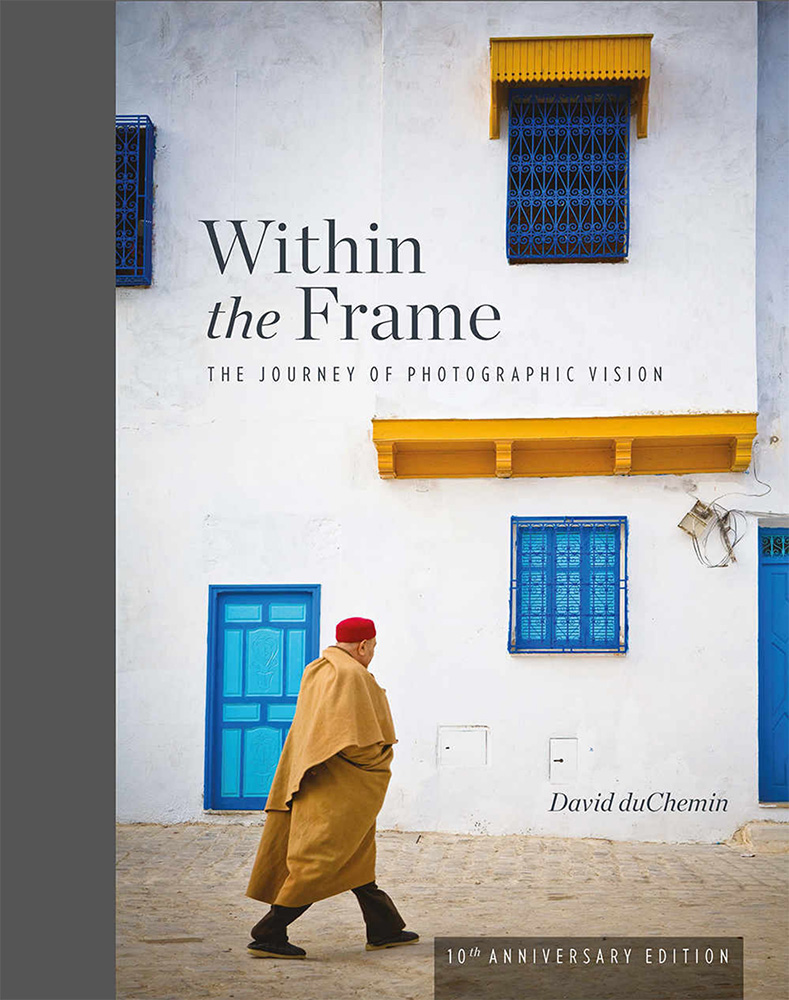
by successfulbob | book review, inspiration, photography, photography books
Within the Frame – David duChemin
I’m a fan
I am a big fan of books. Well, not all books, but good ones. The book I wish to share with you is definitely better than good. I’ve been following David duChemin for quite some time. I enjoy his writing style and sense of humor. He has a way of sharing some big ideas in an understandable way without being ‘preachy.’
As you may have already guessed, I am particularly a fan of David and his writing. His latest book is Within the Frame – The Journey of Photographic Vision. It is a 10th anniversary edition and I’m glad he brought it back. This is a book that can be a help in getting your creative butt in gear whether you are a newbie photographer or a seasoned veteran such as myself. (I suppose you can read that as old, but I digress)

Within the Frame – The Journey of Photographic Vision David duChemin
Creativity and Vision
David talks about vision and creativity in most of his writing. I enjoy his introspection and dedication to the photography world and the creative vibe therein. He shares ideas on how to accomplish some inner thinking in bite sized pieces that can be practiced and digested in as small or large a helping as one would like.
An Example
Here’s one paragraph from the book that appears on page 79 in the chapter titled The Artist and the Geek.
“The first thing to realize is that the creative process is not so simple that it can be reduced to a formula-go here, wait for muse, shoot brilliant image. It is not a reactive process dependent on a magic fairy appearing and beating you with an inspiration stick. Creativity is something you can actively work at, and the more closely you know your own process, the more reliably the muse appears. Having said that, I think we all know that some days just do not got he way we want, and we often chalk that up to being uninspired, or bored, or lazy. Probably the latter two.” – David duChemin
Conclusion
The paragraph above has so much about which to think, you can imagine how much you will get from the rest of the book! duChemin’s book is a winner on so many levels. I think it is the kind of book that will earn a long stay in your regular reading table. And, will also have a place of honor in your permanent photography book collection for review on a regular basis.
Yours in Creative Photography, Bob
PS – Get the book. you’ll be glad you did. Within the Frame – The Journey of Photographic Vision
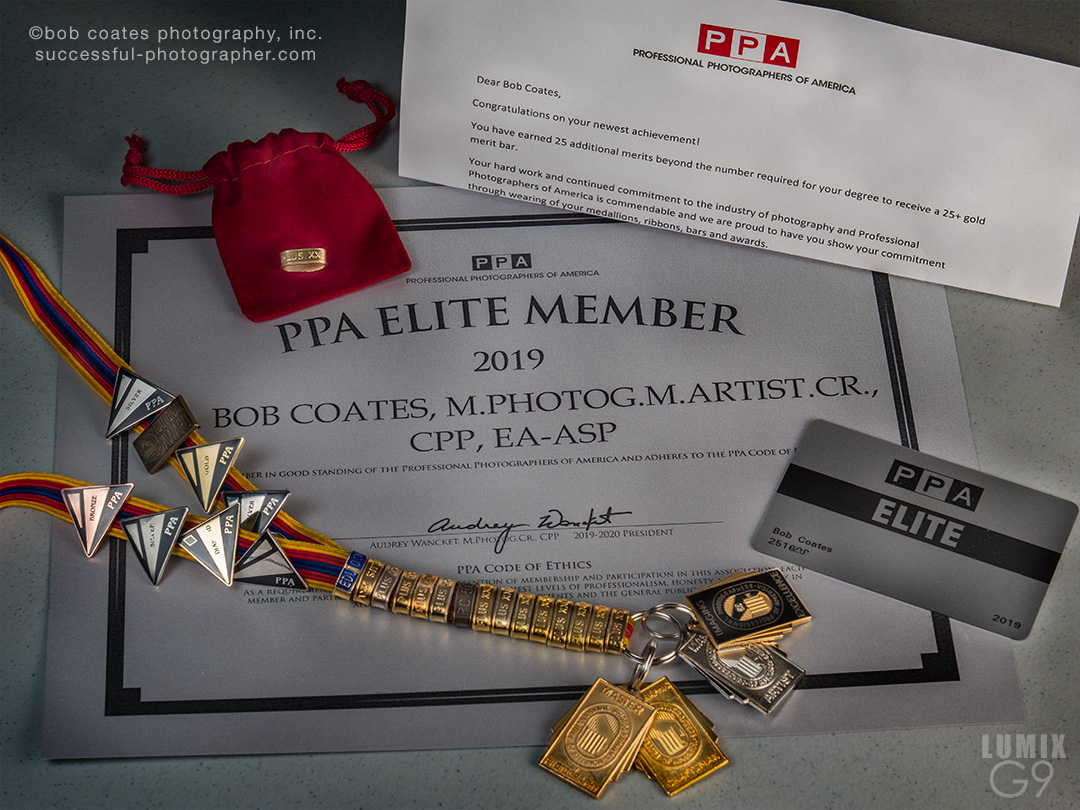
by successfulbob | photography
Elite Photographer Designation
I have been fortunate to receive the Professional Photographers Association Elite Photographer again for 2019. I also received a 25 – Plus bar signifying an additional 25 Merits earned.
So what are these ‘merits’?
They’re essentially a way for a photographer to learn and grow professionally while becoming more active in the industry. You can earn different kinds of merits, all of which are guaranteed to make you a more well-rounded professional photographer! merits are earned through image competition, teaching and service to the industry
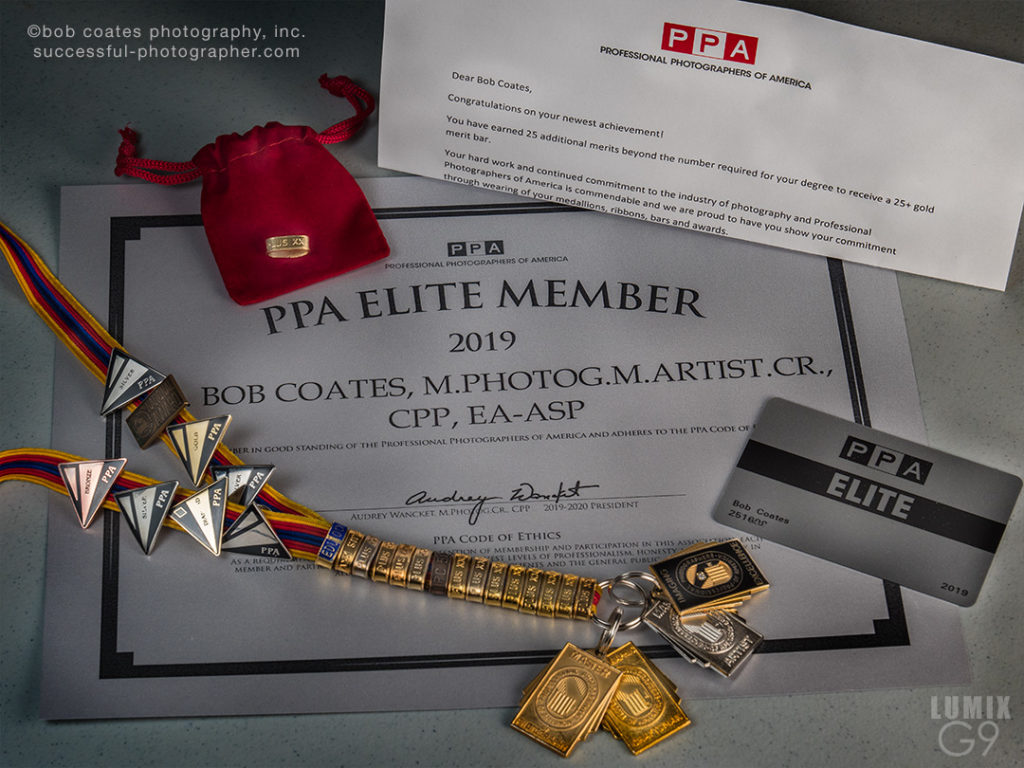 Elite Certificate and 25 – Plus Merit bar
Elite Certificate and 25 – Plus Merit bar
There’s a reason this is such a prestigious level of PPA membership. It requires a lot of hard work and professional accomplishments. It cannot be requested or bought. One automatically qualifies for Elite status when all of the requirements are met by December 31st of each year:
- Certified Professional Photographer
- Master of Photography or Master Artist degree
- Scored four for four on images from a single case from the most recent IPC (bronze, silver, gold, platinum, or diamond)
- Earned two non-photographic merits that year
- And be a PPA member in good standing
Proud to be a PPA member. If you have any questions about the benefits and reasons to be a member get in touch.
Yours in Creative Photography, Bob

by successfulbob | Guest Post, photography, travel photography
Travel in China – Xi’an – Part Three
Guest Post – Ken MacAdams
See the previous posts from Ken on Xi’an, China. Part One and Part Two
“Discovered in 1974 by a peasant digging a well, the tomb area covers about 22 square miles. The main part of the emperor’s tomb has yet to be excavated, but three pits have been discovered and excavation work continues to this day. Some estimate that there are over 8,000 clay warriors at the site. These pottery figures of soldiers, horses and chariots leave no doubt that the emperor wanted a bodyguard in the afterlife. Pit 1 alone has yielded over 6,000 soldiers, plus horsemen and chariots. These soldiers are slightly larger than life size, and each is different from the others. The soldiers wear a variety of uniforms and body armor, different hair styles, and some sport mustaches. Some are kneeling – indicating they were archers holding now-decayed wooden bows or cross-bows, while others would have held swords or pikes. The figures are a fascinating link to a society 22 centuries ago.
 This is the Bell Tower with contrasting modern buildings in the background.
This is the Bell Tower with contrasting modern buildings in the background.
During the daytime you can enter both the Bell and Drum Towers. A few dynasties – and centuries – later, the Ming dynasty erected one of the most famous and best examples of ancient city walls. Construction of the still standing present day wall began on the remains of the old Sui and Tang dynasty walls. Encompassing the old city, the square shaped Ming Wall is 8.5 miles in circumference, 40 ft. tall, and about 45 ft. wide on top. It was purposely built wide enough that two chariots could pass by each other with ease. A moat surrounds the wall, and there were four gates into the city, one on the North, East, South, and West sides. The South Gate is the best preserved example with it’s massive archers tower still intact, along with the drawbridge. Xi’an’s Old City Wall is the only ancient wall in China to have survived the Cultural Revolution in its entirety.
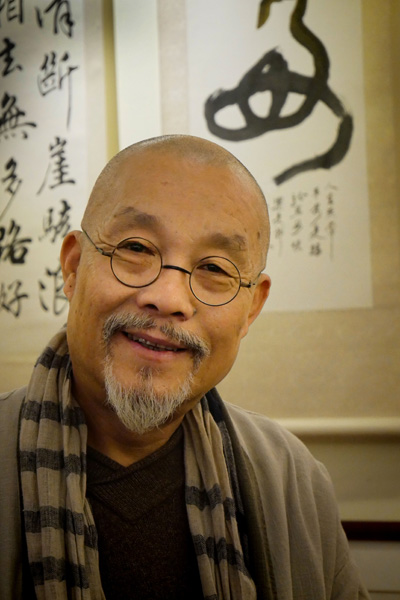 This is an artist in the Art Gallery District who invited us in to join him for a tea ceremony. After visiting, he painted a calligraphy spread, and insisted we take it as a gift! Some of his work is hanging in the background.
This is an artist in the Art Gallery District who invited us in to join him for a tea ceremony. After visiting, he painted a calligraphy spread, and insisted we take it as a gift! Some of his work is hanging in the background.Each Ming city had a bell and drum tower. The bell was sounded at dawn, and drum at dusk. The original bell no longer exists, but a replica stands on the corner of the tower. The bell and drum signaled the opening and closing the city gates. Several cities still have their bell and drum towers, but Xi’an’s is the most widely known of all of them. The Bell Tower was built in 1384 AD and the Drum Tower built four years earlier, in 1380. Today, both towers, and all wall buildings are outlined in colorful LED lights that come on at dusk. The lighting is tastefully done, and adds a special magic to the night air of Old Town Xi’an!
A few blocks away is Xi’an’s Muslim community. Within is the Great Mosque, surrounded by old houses and narrow streets. The Great Mosque survived the Cultural Revolution and remains as an Islamic place of worship. It was founded in AD 742, and the present layout dates from the 14th century.
About 146 BC, during the Han dynasty, Emperor Han Wudi launched a series of military campaigns against the warlike Turkish people to the Northwest. Merchant caravans followed the armies, and established routes that the Europeans later called the Silk Road. Originating in Xi’an, these routes formed links of trade and cultural exchange to the West. Paper, gunpowder, (both Chinese inventions), spices, silk, jade, and many other goods were carried by merchant caravans to the West.
The first contacts between adherents of Buddhism and the Chinese were made by the opening of the Silk Road. (It was via this same link that the Muslim faith came into China.) During the Tang dynasty, Xi’an became the main center for Buddhist learning in Asia. A number of monuments bear witness to the importance of Buddhism in the city’s history. Two prominent landmarks still standing today are the Big and Little Goose Pagodas. Numerous Chinese monks, scholars and translators are recorded having made the journey to India in search of enlightenment. It was at the Little Goose Pagoda where monks spent 20 years translating and converting the Indian language documents into Chinese. The Big Goose Pagoda may have been at tall as 12 stories, but either fire or an earthquake (historical documents vary) damaged the original structure, and it was reduced to 7 stories, as it stands today. You can climb 288 steps inside to the top of the pagoda. On a clear day, your efforts will reward you great views of the surrounding city.
Today, Xi’an continues to grow. By 1954 the city outgrew the Old City walls, and began to spread. The population today stands at about 11 million, of which I’m told 1 million are university students. Pharmaceuticals, electronics, and auto parts are among the industries here, and agriculture plays a significant role in the surrounding area.
In a culture significantly different from ours, I’ve made multiple friends and acquaintances that welcome me back year after year. Each visit I find new subjects to train my lens on, or in some cases, explore a new angle to shoot from. This land is intriguing, charming, and wonderful to experience up close and personal. It’s also a land that’s changing – and changing fast! I’m glad to be documenting some of the ancient along with that change.”
Ken has always loved to travel, so when he made a common connection with the fact that either a long day pounding the streets of some foreign city, or shooting the last dance at a wedding, a good part of his physical

weariness came from lugging around his big heavy DSLR. That’s when he started looking at alternatives – and ended up selecting Panasonic Lumix Micro Four Thirds gear.
Ken is rarely without a camera, and the next great photo travel experience – whether local or abroad – is always in the back of his mind! A longtime resident of the Four Corners, and when he’s not out on the road, he enjoys some of the great outdoor opportunities found there – mountain biking, hiking, and Jeeping.
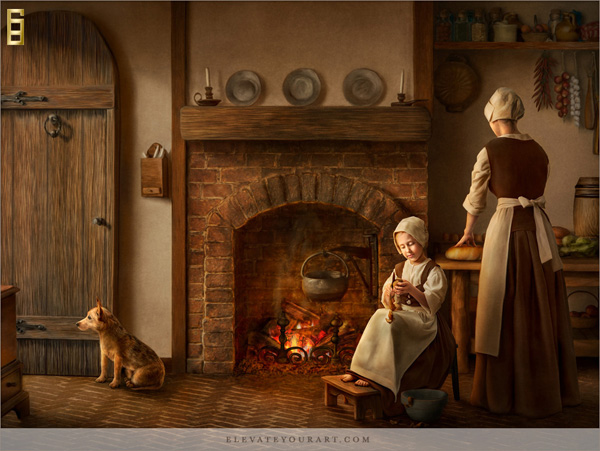
by successfulbob | fine art photography, fine art portrait, imaging competition, photography, tuesday painterly photo art
Tuesday Painterly Art – Part Two
Michelle Parsley – M.Photog, M. Artist, Cr., CPP
I had the pleasure of taking a Michelle Parsley full day Pre-Con class at Imaging USA this year. I was extremely impressed with her attention to detail and classroom style. If you ever get the opportunity to learn from Michelle, I highly recommend it. BTW you can also work with Michelle online. Check out links to her education at the bottom ot the post.
Hear again from Michelle as she continues her talk about her work and producing images for PPA’s International Photographic Competition
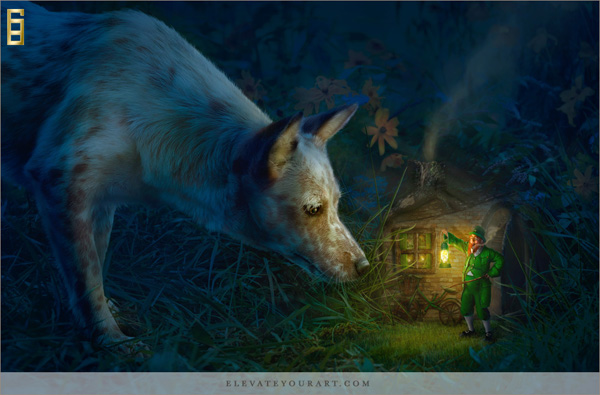
“Another glimpse into my imagination would be “Get off my lawn!”. Who hasn’t thought of
finding a Leprechaun? Just me?? Oh, ok… ;)
I absolutely love history. You can see the influence of times gone by in images like, “Secret
Admirer”, “Patchwork”, “Waiting for Papa”, and “All in a Day’s Work”. These were some of my
favorite images I’ve ever created — partly because of the historical context, but also because I
built the “sets” in scale miniature and composited my subjects into the scenes. None of those
rooms are more than 12 inches tall!
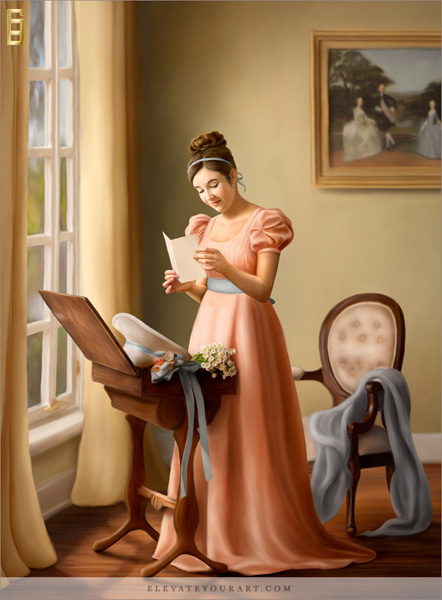 “Secret Admirer”
“Secret Admirer”
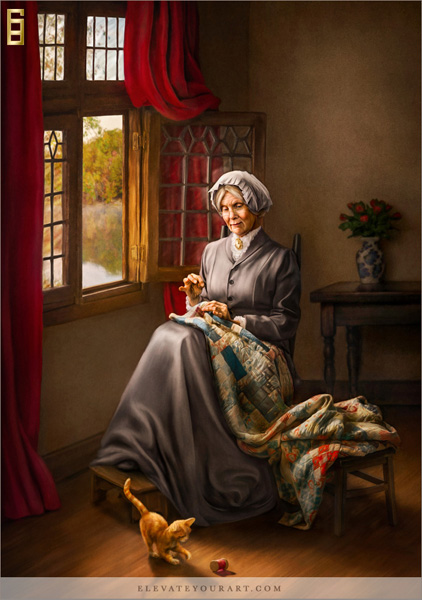 “Patchwork”
“Patchwork”
 “Waiting for Papa”
“Waiting for Papa”

“Source of Wisdom”
Easily one of the craziest things I have ever done for print competition was “The Source of
Wisdom”. This print really has to be seen in person to appreciate it. I knew by adding 3D
elements to the print, I was risking being disqualified — but it was something I just had to try. I
have an absurd amount of time in both building the set (I made over 300 books the size of my
thumbnail!!), compositing over 50 frames together, and then adding the miniature books to the
face of the print to give the final piece a 3D feel. At one point I found myself VACUUMING the
print to be 100% sure none of my elements would damage anyone else’s entry. Thankfully –
the judging panel really understood the story and rewarded me with a loan. One word of
caution — if you ever attempt a 3D print, ALL of the 3D elements must be below the face of the
mat or you could potentially be DQ’d for damaging other entries. Proceed with caution!”
Michelle Parsley, M.Photog, M. Artist, Cr., CPP
Behind every artist there is a story and Michelle’s story began as a child when she would draw or paint with anything she could find (which got her in trouble on more than one occasion!). She has been creating hand drawn and hand
painted art for clients for nearly 20 years. Michelle is mostly self-taught in all the mediums she uses to express
her creativity. By combining her love of both digital and organic mediums, Michelle is uniquely equipped to both create and teach art. Michelle earned her Certified Professional Photographer (CPP) designation from Professional
Photographers of America (PPA) in 2009 which led her to enter her first International
Photographic Competition in 2010.
She has since earned the Master of Photography 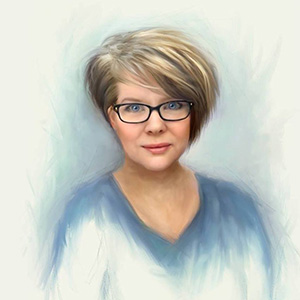
and Master Artist degrees in 2014, diamond artist of the year in 2012, the
Imaging Excellence Award in 2015, Photographic Craftsman in 2017, Double diamond and the Imaging Excellence Bar in 2018.
When Michelle is not teaching, photographing, or painting, she enjoys a great cup of coffee, dark chocolate, and working on the family farm in rural Tennessee where she lives with her husband of over 25 years, their four children, four dogs, and an ever changing host of farm animals.
The class I took from Michelle – Photoshop Clone Painting
More Clone Painting Classes – All Clone Painting Classes
General Teaching site – Elevate Your Art
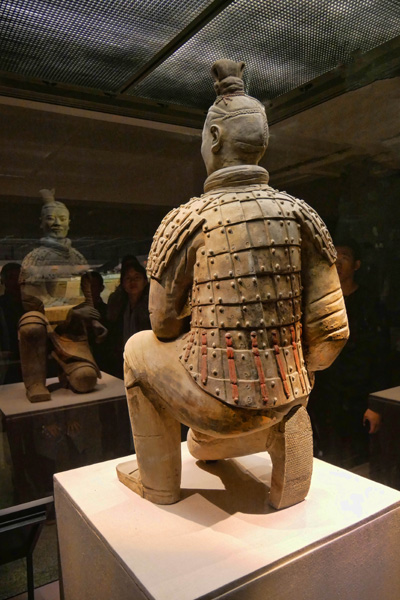
by successfulbob | Guest Post, landscape photography, Lumix G9, photography, travel photography
Travel in China – Xi’an – Part Two
Guest Post – Ken MacAdams
Ken’s continuing images and stories from Xi’an, China. See the last post here.
“For this blog edition, let me introduce you to some background of this interesting locale.
 This is Fengqing Park, one of the many beautiful parks within the city.
This is Fengqing Park, one of the many beautiful parks within the city.
It’s a quiet place where the locals come from dawn to dusk.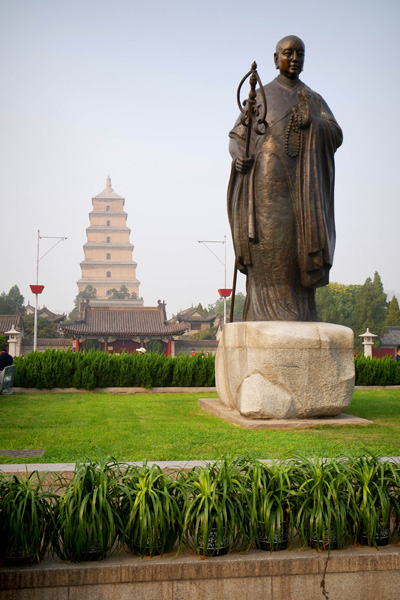 Wild Goose Pagoda with the statue of the monk credited with bringing Buddhism to China.
Wild Goose Pagoda with the statue of the monk credited with bringing Buddhism to China.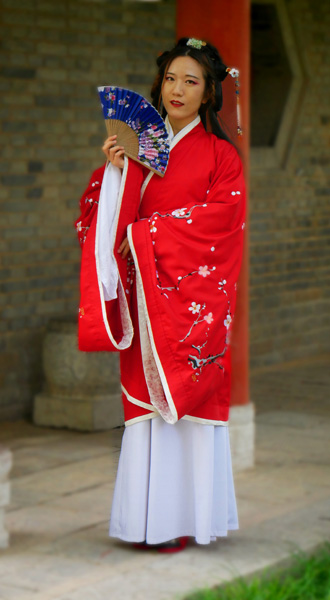 Woman dressed in Period costume at the Little Goose Pagoda.
Woman dressed in Period costume at the Little Goose Pagoda.In the history of China, Xi’an has played a large and significant role – one that stretches longer in time than perhaps any other city in China. It acted as the capital of China for over 1,100 years, and has never fallen out of importance. Archaeological and art discoveries in and around the city tell a tale of China’s development from prehistoric times until the height of the imperial period. Many tombs and sites remain un excavated to this day. Xi’an is geographically located in the center of present day China.
 Pit 1. This is the first pit that was discovered and where excavation began.
Pit 1. This is the first pit that was discovered and where excavation began.
It is estimated there are 6,000 soldiers buried here. Note the armor detail and remaining paint pigment. The sole of his shoe even has tread detail!
Note the armor detail and remaining paint pigment. The sole of his shoe even has tread detail!Xi’an lies on the Wei River in the Shaanxi Province, and served as capital at different times for the Zhou, Han, Sui, and Tang dynasties. The origins of Xi’an can be traced to the 11th century BC, when rulers of the Zhou dynasty founded a city about 10 miles from present day Xi’an. In 221 BC the King of Qin conquered the other feudal kingdoms in the region to become the First Emperor. During his rule, he extended various sections of the Great Wall to keep out the fierce northern tribesmen, but perhaps more notable was his standardization of the Chinese written language, coinage, and weights and measures. It was Qin who was responsible for another of the greatest wonders of the ancient world – his army of terracotta warriors.
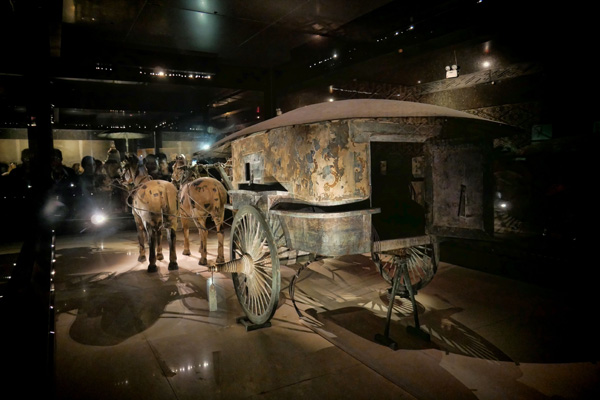 This is the bronze chariot for the Emperor. It weighs almost 2,000 lbs., and silk fabric was found inside.
This is the bronze chariot for the Emperor. It weighs almost 2,000 lbs., and silk fabric was found inside. More from Ken’s adventures next week!
Ken has always loved to travel, so when he made a common connection with the fact that either a long day pounding the streets of some foreign city, or shooting the last dance at a wedding, a good part of his physical

weariness came from lugging around his big heavy DSLR. That’s when he started looking at alternatives – and ended up selecting Panasonic Lumix Micro Four Thirds gear.
Ken is rarely without a camera, and the next great photo travel experience – whether local or abroad – is always in the back of his mind! A longtime resident of the Four Corners, and when he’s not out on the road, he enjoys some of the great outdoor opportunities found there – mountain biking, hiking, and Jeeping.

 Born and raised in Coronado California he joined the US Navy in 1980 and served for 29 years. During his US Navy travels including 137 countries, he began “capturing” life around him. In 2010, Kelly began his pursuit of professional portraiture, growing and developing his skills in creating “salient” portraits focused on weddings portraiture and boudoir.
Born and raised in Coronado California he joined the US Navy in 1980 and served for 29 years. During his US Navy travels including 137 countries, he began “capturing” life around him. In 2010, Kelly began his pursuit of professional portraiture, growing and developing his skills in creating “salient” portraits focused on weddings portraiture and boudoir. Arts ksfinearts.com focuses on Boudoir and Fine Art portraiture and workshops.
Arts ksfinearts.com focuses on Boudoir and Fine Art portraiture and workshops.





























